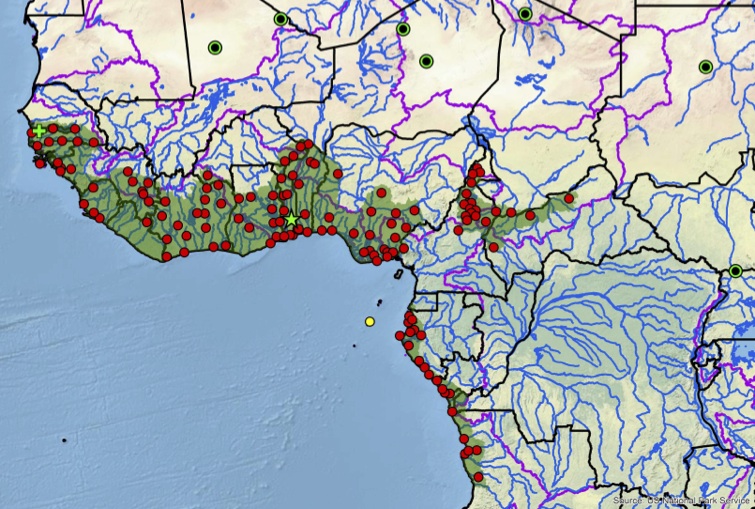Pelusios castaneus, 095
Pelusios castaneus (Schweigger 1812) –
West African Mud Turtle, Swamp Terrapin
Roger Bour1, Luca Luiselli2,5, Fabio Petrozzi3,5,
Gabriel Hoinsoudé Segniagbeto4, and Laurent Chirio6
1Reptiles & Amphibiens, UMR 7205 OSEB, Département de Systématique & Evolution,
Muséum national d’Histoire naturelle, 25 rue Cuvier, 75005 Paris, France [[email protected]];
2IDECC – Institute for Development, Ecology, Conservation and Cooperation,
via G. Tomasi di Lampedusa 33, 00144 Rome, Italy [[email protected]];
3Ecologia Applicata Italia s.r.l., via E. Jenner 70, 00151, Rome, Italy [[email protected]];
4Département de Zoologie et Biologie animale, Faculté des Sciences,
Université de Lomé, BP 1515, Lomé, Togo [[email protected]];
5Department of Applied and Environmental Biology,
Rivers State University of Science and Technology, PMB 5080, Port Harcourt, Nigeria;
6P.O. Box 87811, Riyad 11652, Saudi Arabia [[email protected]]
Summary. – The West African Mud Turtle, Pelusios castaneus (Family Pelomedusidae), is an aquatic turtle of moderate size (carapace length to ca. 250–285 mm) indigenous primarily to savannah environments, but widely tolerant in terms of habitat requirements, and also able to penetrate into some forest and mangrove zones. It has rather variable coloration, but is recognizable by the pattern of fine, sinuous vermiculations on the head and the light plastron, unmarked except for angular figures around its periphery that may be either distinct or contiguous. In addition, the narrow, elliptical intergular scute and the very short pectorals are characteristic. Its field ecology has been studied extensively and quantitatively only in southern Nigeria, with such disparate features as home range, habitat selection, and food habits being analyzed. The species is omnivorous (but primarily carnivorous), with dietary composition shifting by season and by site, and also in relation to site pollution. The adult sex ratio is even. The species may potentially be a competitor of P. niger in the forest water bodies of southern Nigeria, and especially in the oil-polluted areas, due to an increased niche similarity between these species along the spatial and food niche axes. Pelusios castaneus is locally abundant, and its populations appear to be stable.
Distribution. – Angola, Benin, Burkina Faso, Cameroon, Central African Republic, Chad, Congo (DRC), Congo (ROC), Equatorial Guinea (?), Gabon, Ghana, Guinea, Guinea-Bissau, Ivory Coast, Liberia, Mali (?), Niger, Nigeria, São Tomé and Príncipe (probable historic introduction), Senegal, Seychelles (extirpated; possible historic introduction), Sierra Leone, Togo. The species has a substantial but apparently disjunct distribution with three separate populations in western Africa, extending from Senegal to Angola.
Synonymy. – Emys castanea Schweigger 1812, Pelusios castaneus, Chelys (Sternotherus) castaneus, Chelys castaneus, Sternotherus castaneus, Clemmys (Pelusios) castanea, Clemmys castanea, Sternothaerus castaneus, Sternothaerus nigricans castaneus, Sternothaerus nigricans castanea, Pelusios nigricans castaneus, Pelusios subniger castaneus, Pelusios castaneus, Pelusios castaneus castaneus, Sternothaerus leachianus Bell 1825, Sternotherus leachianus, Sternotherus derbianus Gray 1844, Sternothaerus derbianus, Pelusios derbianus, Pelusios castaneus derbianus.
Subspecies. – None recognized until recently, despite the wide range and the morphological variability of this species. However, several taxonomic combinations have been proposed. The taxon has previously been variously included as a subspecies of Pelusios subniger (Bonnaterre 1789) and Pelusios nigricans (Donndorff 1798). There is current controversy surrounding the taxonomic position of Pelusios castaneus seychellensis (Siebenrock 1906), considered to be a closely related but distinct species by Bour (1983) and Bour and Gerlach (2008), but as a historically introduced synonym of P. castaneus by Stuckas et al. (2013) and Kindler et al. (2016). Based on morphology, Bour (2013) recognized P. c. seychellensis as a possibly historically introduced distinct subspecies, and the TTWG (2014) and we continue to follow this taxonomy here, pending further analysis.
Status. – IUCN 2015 Red List Status: Not Listed (Least Concern, LC, assessed 1996); TFTSG Draft Red List: Least Concern (LC, assessed 2013); CITES: Not Listed.
Citation:
Bour, R., Luiselli, L., Petrozzi, F., Segniagbeto, G.H., and Chirio, L. 2016. Pelusios castaneus (Schweigger 1812) – West African Mud Turtle, Swamp Terrapin. In: Rhodin, A.G.J., Pritchard, P.C.H., van Dijk, P.P., Saumure, R.A., Buhlmann, K.A., Iverson, J.B., and Mittermeier, R.A. (Eds.). Conservation Biology of Freshwater Turtles and Tortoises: A Compilation Project of the IUCN/SSC Tortoise and Freshwater Turtle Specialist Group. Chelonian Research Monographs 5(9):095.1–11, doi:10.3854/crm.5.095.castaneus.v1.2016, //iucn-tftsg.org/cbftt/.
(Adobe Acrobat 6.0 or later required)

Adult male Pelusios castaneus from Togoville, Togo.
Photo by Gabriel H. Segniagbeto.
Distribution:

Distribution of Pelusios castaneus in western and central Africa. Purple lines = boundaries delimiting major watersheds (level 3 hydrologic unit compartments – HUCs); red dots = museum and literature occurrence records of native populations based on Iverson (1992), plus more recent and authors’ data; yellow dot = introduced population; large green dots with black centers = Pleistocene and Holocene fossils referred to P. castaneus; green star = restricted type locality of P. castaneus; green cross = restricted type locality of synonymous P. derbianus; green shading = projected current distribution based on GIS-defined level 8 HUCs constructed around verified localities and then adding HUCs that connect known point localities in the same watershed or physiographic region, and similar habitats and elevations as verified HUCs (Buhlmann et al. 2009; TTWG 2014), and adjusted based on authors’ subsequent data. The distributional discontinuity in the central Cameroon portion of the range is due to lack of records from the deep equatorial forests in this region, which have apparently served as an isolating mechanism for the three separate populations.








